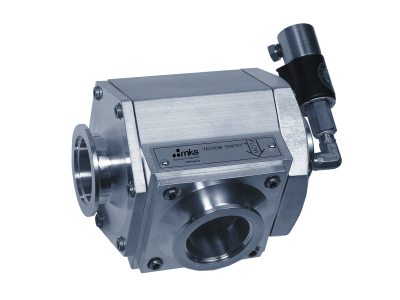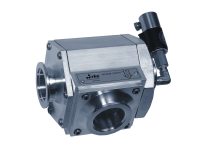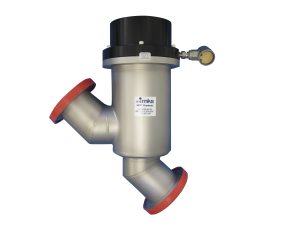145 Vacuum Sentry® Safety Isolation Valves
Overview
Series 225 Auto-Soft Flow Actuated Check Valves are safety valves that protects a vacuum system upon power failure by isolating the system and venting the mechanical pump. This eliminates time consuming and costly cleanup of your vacuum lines caused by oil back streaming from the pump. The small orifice in the Vacuum Sentry valve also vents the mechanical pump to atmospheric pressure for easy restart when the power returns. This design requires no external pressurized gas source.
- NW25 - NW50
- Protects vacuum system from oil back streaming in the event of power failure
- Enables quick system restarts by venting the pump to atmosphere
Products
| Compare | Description | Drawings, CAD & Specs | Availability | Price | |||
|---|---|---|---|---|---|---|---|

|
Vacuum Safety Valve, ISO-KF Flanges, NW25 Angle Ports, Viton Seals, 120 VAC/60 Hz
$514
|
145-0025K-120V/60 Vacuum Safety Valve, ISO-KF Flanges, NW25 Angle Ports, Viton Seals, 120 VAC/60 Hz |
15 Weeks

|
$514 |
|
||

|
Vacuum Safety Valve, ISO-KF Flanges, NW25 Angle Ports, Viton Seals, 220 VAC/50-60 Hz
$514
|
145-0025K-220V/50-60 Vacuum Safety Valve, ISO-KF Flanges, NW25 Angle Ports, Viton Seals, 220 VAC/50-60 Hz |

|
$514 |
|
||

|
Vacuum Safety Valve, ISO-KF Flanges, NW25 Angle Ports, Viton Seals, 24VDC
$514
|
145-0025K-24VDC Vacuum Safety Valve, ISO-KF Flanges, NW25 Angle Ports, Viton Seals, 24VDC |

|
$514 |
|
||

|
Vacuum Safety Valve, ISO-KF Flanges, NW40 Angle Ports, Viton Seals, 120 VAC/60 Hz
$541
|
145-0040K-120V/60 Vacuum Safety Valve, ISO-KF Flanges, NW40 Angle Ports, Viton Seals, 120 VAC/60 Hz |

|
$541 |
|
||

|
Vacuum Safety Valve, ISO-KF Flanges, NW40 Angle Ports, Viton Seals, 208 VAC/60 Hz
$541
|
145-0040K-208V/60 Vacuum Safety Valve, ISO-KF Flanges, NW40 Angle Ports, Viton Seals, 208 VAC/60 Hz |
15 Weeks

|
$541 |
|
||

|
Vacuum Safety Valve, ISO-KF Flanges, NW40 Angle Ports Viton Seals, 220 VAC/50-60 Hz
$541
|
145-0040K-220V/50-60 Vacuum Safety Valve, ISO-KF Flanges, NW40 Angle Ports Viton Seals, 220 VAC/50-60 Hz |
15 Weeks

|
$541 |
|
||

|
Vacuum Safety Valve, ISO-KF Flanges, NW50 Angle Ports, Viton Seals, 120 VAC/60 Hz
$563
|
145-0050K-120V/60 Vacuum Safety Valve, ISO-KF Flanges, NW50 Angle Ports, Viton Seals, 120 VAC/60 Hz |
15 Weeks

|
$563 |
|
||

|
Vacuum Safety Valve, ISO-KF Flanges, NW50 Angle Ports, Viton Seals, 208 VAC/60 Hz
$563
|
145-0050K-208V/60 Vacuum Safety Valve, ISO-KF Flanges, NW50 Angle Ports, Viton Seals, 208 VAC/60 Hz |
15 Weeks

|
$563 |
|
||

|
Vacuum Safety Valve, ISO-KF Flanges, NW50 Angle Ports, Viton Seals, 220 VAC/50-60 Hz
$563
|
145-0050K-220V/50-60 Vacuum Safety Valve, ISO-KF Flanges, NW50 Angle Ports, Viton Seals, 220 VAC/50-60 Hz |
15 Weeks

|
$563 |
|
Configuration Options
Please see Vacuum Sentry datasheet for available product options.
Specifications
-
TypeSafety Valve
-
Body ConfigurationAngle
-
Port SizeNW25, NW40, NW50
-
Helium Leak Rate<1 X 10-9 std cc/sec He
-
Body MaterialsAL 6061-T6
-
SealViton®
-
Closing Burst1 X 10-3 T-1
-
Power7 W @115 VAC
-
Piston MaterialAL 2024
-
Guide Pin MaterialViton®
-
Closing Time30 ms
-
Maximum Operating TemperatureValve: 100° C
Solenoid: 55° C -
Venting Time10 s/l of vented volume
Features
Vacuum Sentry Operation
Vacuum Sentry’s solenoid valve is connected in parallel with the mechanical pump’s electrical supply either at its source or at the pump’s switch. When the electrical power is on, the solenoid valve is held closed, allowing the pump to keep Vacuum Sentry’s body and the vacuum system evacuated. Interruption of electrical power to the mechanical pump causes the solenoid valve to open, admitting air into the Vacuum Sentry, causing it to close. This isolates the vacuum system. The pressure differential between the outside atmosphere and the vacuum system provides the force to maintain the valve in its closed position without electrical or pneumatic power. With the vacuum system isolated, a series of small orifices admits air into the inlet port of the mechanical pump until it has risen to atmospheric pressure. When the power comes back on, the solenoid closes the pump. The mechanical pump is then restarted, and evacuates the area above the piston until the pressure is lowered to approximately that of the vacuum system. Vacuum Sentry opens again allowing the vacuum system to be pumped at the full speed of the mechanical pump.
Maximizes Pumping Conductance
Vacuum Sentry is constructed of vacuum compatible materials and maximizes pumping conductance. Lifetimes in excess of 100,000 cycles are typical, which translates into years of trouble free use in suitable environments. The opening burst is less than the critical backing pressure for turbomolecular and diffusion pumps when appropriately sized mechanical pumps are used. The closing burst is minimized by the buffer volume design. Vacuum Sentry consumes little power. Installation is simple, because the standard ISO-KF dimensions are used for the NW 40 and NW 50 sizes. This allows the valve to replace elbows, tees, and crosses of the same size. Even when the mechanical pump is equipped with an anti-suckback valve, Vacuum Sentry should be used, because the pump’s integral valve will not vent it.
Resources
Manuals
- Series 145 Vacuum Sentry Safety Valve Manual (380.2 kB, PDF)
Literature
- 145 Vacuum Sentry Safety Valve (286.5 kB, PDF)




 Ultra-High Velocity
Ultra-High Velocity